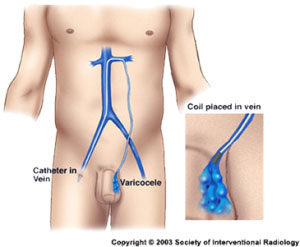
You have a pain you’ve never experienced before. It has you worried. You may feel a little awkward talking about it. The fact that the pain is in your testicle makes it even more uncomfortable to talk about — even with your doctor. However, what you’re experiencing might be a symptom of a condition known as varicocele, which is essentially a varicose vein in your scrotum — the good news is there’s something you can do about it.
What is Varicocele and Why Does My Testicle Hurt?


Varicocele is basically a varicose vein in your scrotum that’s caused by improper blood flow. Your testicular veins run along the spermatic cord and each vein has valves that are supposed to keep blood flowing. Sometimes, these valves malfunction and blood backs up and pools in areas along the spermatic cord. This causes the veins to swell and widen, similar to varicose veins in legs, and a varicocele forms.[i]
Many men with varicocele have no symptoms at all, and the condition is discovered during an exam. Often men discover they have varicocele when they begin investigating fertility issues because this condition can affect sperm counts and quality.[ii]
However, symptoms of varicocele can include pain, with a common symptom being that one testicle hurts. You may feel pain in the area of either the right or left testicle, but rarely both, as it is uncommon to have varicocele on both sides.[iii] Most often, varicocele affects the left testicle.
The Anatomy of Testicular Pain
Approximately 95 percent of all varicoceles occur on the left side.[iv] The reason it occurs more often on the left, causing left testicle pain, is related to the position of the left testicular vein. The left testicular vein is positioned at an angle that may make it difficult for blood to travel. This increases the chance of blood pooling, which can lead to varicocele. In the event the varicocele does occur on the right side, it may lead to right testicle pain.[v]
How to Identify Testicular Pain Caused By Varicocele
Some of the characteristics of varicocele related pain are:
- Varies in intensity from dull to sharp discomfort.
- Increases when you stand or are involved in physical activity.
- Is felt when you “bear down” while lifting, or during bowel movement.
- Gets worse throughout the day.
- Goes away when you lie down.[vi]
There are other physical symptoms of varicocele that may include:
- Visible twisted veins in the scrotum.
- Swelling of the scrotum or testicles.
- Lumps in one or (rarely) both testicles or a mass in your scrotum. [vii] [viii]
It’s important you see a doctor if you suspect you may have varicocele, as there is always a possibility that your symptoms may be related to another medical issue, particularly if there is a mass in your scrotum.[ix]
Is Varicocele Harmful to Me?
Generally, varicocele is considered to be a minor condition. However, it has been connected to infertility and low testosterone. Low testosterone affects men more as they age and can lead to ongoing health problems like low energy, decreased muscle strength, impotence, [med term alert] osteopenia (low bone mineral density), osteoporosis, and a decline in cognitive functions.[x] Although varicocele is usually not directly linked to more serious health conditions, doctors often advise corrective measures be taken if it causes pain or inhibits your life or fertility.
How Did I Get Varicocele?
Statistics show roughly 15 percent of all men suffer from a varicocele. In fact, varicocele often starts forming during puberty, and the highest occurrence is in males ages 15 – 35. In some cases, men get varicoceles from an injury, but most of the time they occur naturally without an established root cause.[xi]
Treatment for Varicocele
There are two treatment options used to treat varicocele. Surgery is one option, and the other choice is for men who want to treat their varicocele in a non-surgical manner. These men may opt for a minimally invasive procedure known as varicocele embolization, an outpatient procedure that has a quicker recovery time when compared to a surgical treatment option.
Some of the benefits of embolization include:
 Unlike surgery, it doesn’t require general anesthesia and can be done using a local anesthetic.
Unlike surgery, it doesn’t require general anesthesia and can be done using a local anesthetic.- There is no incision, reducing the risk of post-procedure infection.
- The recovery period is typically about two days.
- Sexual activities can resume after two weeks (rather than four weeks with surgical procedures).
- The long term success rate is approximately 90%.
- It is cost effective.[xii]
The benefits of obtaining any form of treatment for varicocele include:
- Immediate pain relief.
- Potential for testicle to return to normal size.
- Possible raised testosterone levels.[xiii]
- Increased chance of future pregnancy.
Addressing and treating testicular pain can increase quality of life and offer relief from some of the physical effects that men living with varicocele often experience. Remember, surgery isn’t your only option. Advanced technology and minimally invasive procedures can provide relief that is convenient and effective in the long term. You don’t have to live with testicular pain.
Sources:
[i] https://www.nlm.nih.gov/medlineplus/ency/article/001284.htm
[ii] http://www.mayoclinic.org/diseases-conditions/varicocele/basics/symptoms/CON-20024164
[iii] http://www.healthline.com/health/varicocele#Overview1
[iv] http://www.sirweb.org/patients/varicoceles/
[v] http://www.urologyhealth.org/urologic-conditions/varicoceles
[vi] http://www.mayoclinic.org/diseases-conditions/varicocele/basics/symptoms/CON-20024164
[vii] https://www.nlm.nih.gov/medlineplus/ency/article/001284.htm
[viii] http://www.healthline.com/health/varicocele#Overview1
[ix] http://www.webmd.com/men/guide/testicular-disease?page=2
[x] http://www.nyp.org/news/hospital/goldstein-varicoceles-testosterone.html
[xi] http://www.healthline.com/health/varicocele#Overview1
[xii] http://www.sirweb.org/patients/varicoceles/
[xiii] https://my.clevelandclinic.org/health/diseases_conditions/hic-varicocele


